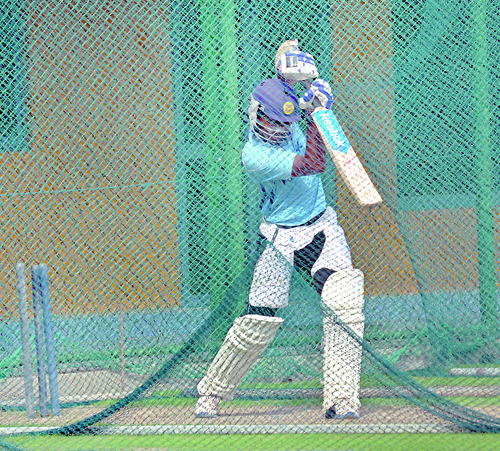Why Lanka’s cricket talent is unique
View(s):Now the cricket summer is over. Here in Sri Lanka it is cricket autumn. Till the IPL rain is over, the majority of the cricketers will take a well-earned break, after three months of continuous hard work.
After the summer’s activity where they won the hearts of the cricketing world with the ICC T-20 trophy, the Lankan game is in a high, but we at this end feel the time is ripe to ponder how this machinery works the way it does and does magic with Sri Lanka cricket — the magic which some other countries, bigger and more affluent than us still dream of.
The brand of cricket we have in Sri Lanka is unique. Sri Lanka does not have the population that India could boast of to choose its cricketers nor does Sri Lanka have the wherewithal to provide the facilities that the Australian cricket authorities throw at their talent at hand. Yet, in our small way, we – the Sri Lankans — have derived a system that oozes talent in abundance. We have a system that engages in quality cricket. We have proven this fact through the ICC challenges from 1979 to date.

It happens all the time. The national cricketers and the rest of the cricketing brood in Lanka get a thorough workout at the Academy - File pic
In 1979, as an associate member, Sri Lanka beat Canada in the final to annex the ICC trophy and then went on to beat Australia in the final of the 1996 World Cup — the plum of the cricket trophies — in the ICC 50 overs edition. Then in 2002, Sri Lanka ended up as the joint holders of the ICC Champions Trophy along with India. Thereafter, in 2007 and 2011, they were featured in the ICC World Cup finals.
For a country that was admitted into the ICC big league only in 1981 and played its first Test match in 1982, it is indeed an achievement to be proud of.
The T-20 version was added into the fray in 2007. During that short period the Lankans have been in three finals – in 2009, 2012 and in 2014 they walked out as winners.
However, it also marks that Sri Lanka maintained the No. 1 position in the T-20 segment from 2012 to date while vindicating their status by the winning the ICC trophy this year.
Winning the T-20 World Cup came in this manner. Though the team had a good balance of youth and experience, there were no individual heroes on whom the team depended heavily upon. It was a concerted team effort with the eleven players putting in their share of the might to a collective achievement. The team effort could be described in only one way. At the end of the tournament, the ICC published its ideal T-20 squad which was chosen by an ICC panel. There was only one Sri Lankan in that squad, in spite of Sri Lanka winning the T-20 trophy and also maintaining the number one position for over a year. The ICC list of names read as: (in batting order): Rohit Sharma (India) – 200 runs, Stephan Myburgh (Netherlands) – 224 runs, Virat Kohli (India) – 319 runs, JP Duminy (South Africa) – 187 runs, Glenn Maxwell (Australia) – 147 runs, MS Dhoni (India – captain, wicketkeeper) – 50 runs, six dismissals, Darren Sammy (West Indies) – 101 runs, Ravichandran Ashwin (India) – 11 wickets, Dale Steyn (South Africa) – nine wickets, Samuel Badree (West Indies) – 11 wickets, Lasith Malinga (Sri Lanka) – five wickets.
 12th Player: Krishmar Santokie (West Indies) – eight wickets.
12th Player: Krishmar Santokie (West Indies) – eight wickets.
This is a clear indication of the quality of cricket played by the Lankans. The gist of the matter is that the Lankans are very lethal as a combination rather than individual units. This has not been an isolated scenario, but a proven fact now. Yes, there was a time where the Lankan cricket was marked and revolved around Muttiah Muralitharan and Chaminda Vaas, but, now this fact goes to prove even their contributions played pivotal roles, but, it was not the entire gamut.
After the retirement of Muralitharan and Vaas, some pundits said that the Lankan cricket would take ions to recover, but in a few years, they have come out with another ICC world title added to their feathers.
Once Sri Lanka Cricket Academy Chief Jerome Jayaratne pointed out that Sri Lanka had one of the most established and inbuilt school cricket systems in the world, because it provides the initial intake to the national grid.
But, how does it sustain itself once the school cricket is over and the cricketer is exposed to the elements? The book says that there is the club cricket system which also established itself in the same manner that the school cricket embedded itself in our soil, but, still there is a certain aspect that goes on unseen and unspoken churning itself almost round the clock for the sake of cricket.
Jayaratne says the coaching staff at the academy sweat and toil keeping the next of kin and even some of the national grid in shape throughout. They have one advantage that the other countries do not have. Most cricketers in the reckoning are only a few hours away from the academy. If they need to work on a given cricketer they can be present at the academy within twenty four hours. Besides, the coaching staff also work within a strong regime where their share of work is cut out in a systematic manner. However, in some cases they take their training to the indoors once the darkness fall and work into the night.
According to Jayaratne, Sri Lanka may lack the facilities that other affluent countries like India New Zealand, Australia could provide, but, the system that has been inculcated works well and effectively. He is of the view that Sri Lanka now has a long list of budding junior players because of this system.
Yet, what is at hand at the academy is not the ideal. It has no indoor facility or a swimming pool. Yet, the intense training goes unimpeded like churning out new tools out of a cricket factory.
Yet, with these limited resources, the Lankan cricket academy sustains and supplies cricketers to the junior system, the club system, the academy teams, the ‘A’ team, the national team and not to mention the women’s team.
Just imagine having a fully-fledged cricket academy with all necessary facilities!


